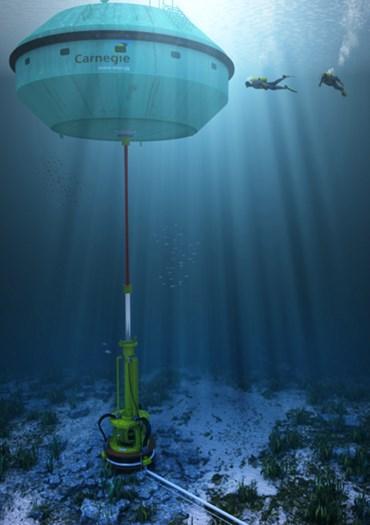
2 minute read
Surfing Towards Renewable Energy
by Heather Roth
This year, an Australia-based company called Carnegie Wave Energy Limited has patented technology, called CETO, that converts the ocean’s energy into power and is able to remove minerals from the water. Over $100 million has been invested to fund the development of the CETO technology. Carnegie operates at two testing sites – a private wave testing facility off the coasts of Western Australia and at HMAS Stirling, Australia’s largest naval base. CETO works by submerging buoys, which are moved by the ocean swell. This motion drives pumps that pressurize seawater delivered ashore by a subsea pipeline. Once onshore, the high-pressure seawater is used to drive hydroelectric turbines that generate electricity. This high-pressure seawater can also be used to supply a reverse osmosis deamination plant, producing freshwater.
Historically, seawater desalination has been extremely energy costly, and some plants are huge emitters of greenhouse gases. However, because of the predictability of the ocean’s behavior, some scientists predict that wave energy can power the entire world. As opposed to traditional energy sources, wave energy is highly available and renewable. Additionally, since water is about 800 times denser than air, the energy density of waves exceeds that of wind and solar, increasing the amount of energy available for harvesting.
CETO units operate in deep water, away from breaking waves. The buoys sit under the water, moored to the sea floor, with minimal visual impacts above the water. This is beneficial because there will be minimal impacts on popular surfing sites, beachgoers will not see the buoys, and swimmers will not have to worry about being near the technology.

Moreover, the units are designed to operate in harmony with the waves. Meaning, apart from their anchor points, there is no need for massive structures to be built. This is also beneficial in preserving the shore’s aesthetic that is contested so much by wind turbines opponents The buoys also act like artificial reefs, increasing the biodiversity in these offshore ecosystems.
Western Australia has a population of about 2.5 million people; therefore being able to generate enough energy from a clean, renewable source would prove to be very beneficial in terms of greenhouse gas emissions or air pollution. Roughly 180,000 homes
in Western Australia use solar panels, so this region is definitely well adapted to using renewable electricity sources. Nonetheless, it should be worthwhile to see how harvesting renewable wave energy transforms the energy sector.






Works Referenced:
Gebreyes, Rahel. "This Underwater Technology Harnesses Ocean
Waves To Make Renewable Energy." Huffingtonpost.com. N.p., 5
Apr. 2016. Web.
Richardson, Jake. "Grid-Connected Wave Power Station Turned On In Australia." CleanTechnica. N.p., 04 Jan. 2016. Web. 16 Apr. 2016.









